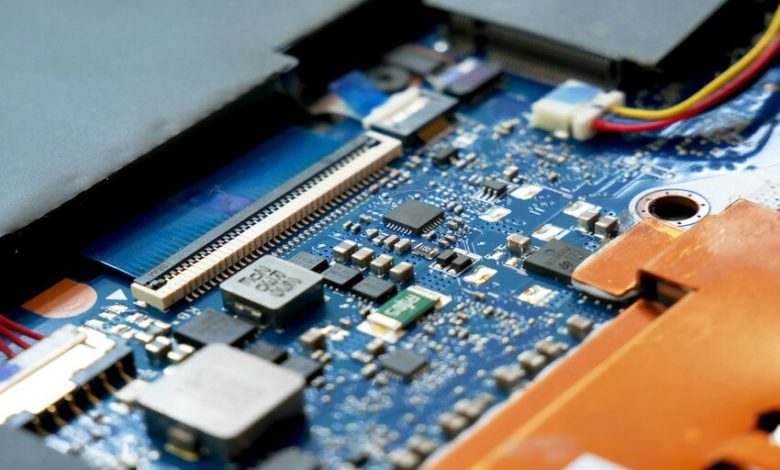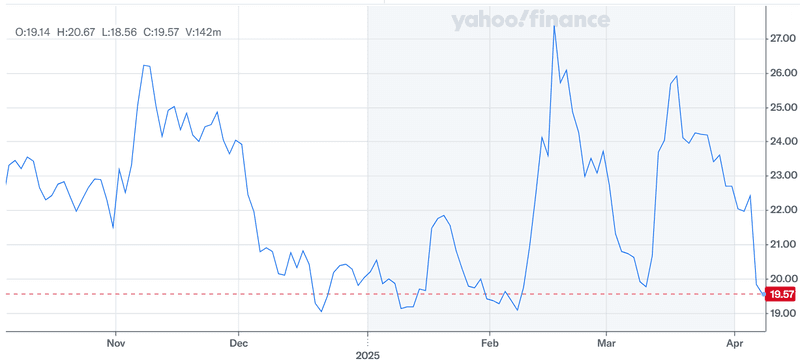Intel’s TSMC Tie-Up Signals Drastic Turnaround — But Will It Be Enough?

Intel Corporation (NYSE:INTC) has entered a make-or-break phase under its newly appointed CEO Lip-Bu Tan, whose leadership has already sparked sweeping changes aimed at reversing the chipmaker’s multi-year decline. The most high-profile development is a tentative joint venture with TSMC, which would involve Intel spinning off some of its loss-making chip-manufacturing units while retaining majority control. In exchange, TSMC is expected to receive a 20% stake and provide critical process expertise, marking a significant strategic shift. While Intel stock initially responded positively, broader market concerns — especially China’s announcement of a 34% tariff on all U.S. goods — sent shares tumbling. This comes at a time when Intel is grappling with weak AI product traction, lost engineering talent, margin compression, and investor skepticism. Tan has acknowledged the complexity of the situation and emphasized the need for long-term cultural and operational transformation.
Restructuring The Foundry Business With TSMC’s Support
One of the most consequential steps in Intel’s turnaround is the proposed joint venture with TSMC, aimed at addressing Intel’s ongoing losses in its chip-manufacturing operations. Intel and other U.S. chipmakers are expected to retain a majority stake in this venture, while TSMC could acquire a 20% share in return for sharing its leading manufacturing techniques. This deal aligns with geopolitical priorities to bring advanced semiconductor production to the U.S., reportedly influenced by pressure from the Trump administration. While the plan could significantly improve the operational efficiency of Intel Foundry Services (IFS), it introduces questions around the relevance of Intel’s 18A node development — which the company had previously positioned as its ticket to regaining process leadership. Analysts have voiced concerns that continued independent development of the 18A process may become redundant and unnecessarily costly, given the access to TSMC’s technologies. At the same time, Intel executives worry the deal may result in layoffs and dilute the importance of Intel’s existing chipmaking expertise. The foundry partnership marks a strategic shift from Intel’s previous stance of maintaining full control over its fabrication and design stack. While the full details remain undisclosed, this move could offload a substantial capital burden from Intel’s balance sheet and enhance its appeal to external foundry clients, but it comes at the risk of ceding technological independence to a longtime rival.
Rebuilding The AI & Data Center Strategy Around Rack-Scale Systems
Intel’s AI roadmap has undergone a dramatic overhaul in 2025, following a series of failed efforts under its previous leadership. The cancellation of the Falcon Shores AI accelerator and the pivot to Jaguar Shores signal a new focus on rack-scale system solutions aimed at competing in the cloud-based AI data center market. This comes in direct response to Nvidia’s launch of the GB200 NVL72, a server rack with 72 interconnected GPUs that has been labeled the apex predator of AI computing. Intel’s Gaudi AI accelerators failed to meet previous revenue expectations, and Tan has acknowledged that Intel’s current AI offerings are insufficient. Rather than attempting to rival Nvidia in GPU performance head-to-head, Tan is focusing on leveraging Intel’s packaging and system integration strengths to deliver custom, scalable solutions. Intel hopes to position Jaguar Shores as a differentiated alternative for hyperscalers like Microsoft, Google, and Amazon, potentially offering better flexibility and integration at the system level rather than the chip level. Additionally, the AI PC market — where Intel maintains a stronger presence — presents another area for potential recovery as partners begin to integrate AI workloads into consumer and enterprise-grade devices. However, execution risks remain significant, and the lack of a proprietary AI accelerator that can rival Nvidia’s CUDA ecosystem places Intel at a disadvantage in high-performance AI markets.
Spinning Off Non-Core Assets To Streamline the Business
Lip-Bu Tan has committed to spinning off Intel’s non-core units in an effort to streamline operations, improve the balance sheet, and refocus the company on its central mission. While specific divestiture targets have not yet been disclosed, the intent is clear: reduce operational complexity and exit areas that no longer align with Intel’s long-term strategy. This restructuring reflects a broader realization that Intel cannot compete effectively across every semiconductor segment while also transforming into a contract chipmaker. The move builds on earlier efforts, including the now-complete $9 billion sale of Intel’s NAND memory business to SK Hynix, which provided a short-term boost to Intel’s financial flexibility. As Intel continues to suffer from margin compression and underperforming assets, spinning off legacy or non-strategic business lines allows management to reallocate capital and talent toward growth verticals such as foundry services, AI rack-scale solutions, and advanced PC chips. However, these moves come with trade-offs. Letting go of once-core capabilities can risk future optionality, and restructuring often leads to headcount reductions, morale concerns, and transitional inefficiencies. For Tan, the challenge lies in executing these divestitures without undermining the capabilities required to deliver on Intel’s future product roadmap or damaging critical customer relationships.
Navigating Geopolitical Risks Amid Escalating Trade Tensions
Intel’s turnaround efforts are unfolding against a backdrop of rising geopolitical tensions, most notably the re-escalation of a trade war between the U.S. and China. On April 4, 2025, China announced a sweeping 34% tariff on all U.S. goods starting April 10 — a move that sent Intel shares down over 8% in a single session. Given that China remains a key end-market for Intel’s products, particularly in PCs and data centers, these tariffs could create significant demand disruption and revenue headwinds. Additionally, Intel’s operational dependence on Asia-based supply chains — including its reliance on TSMC for some wafer production — adds further complexity. The tentative TSMC joint venture, although designed to strengthen U.S.-based semiconductor production, may still be politically sensitive. Tan’s previous investments in Chinese chip firms have already drawn scrutiny from U.S. lawmakers, and Intel’s ability to secure continued CHIPS Act subsidies may depend on strict compliance with evolving export control regulations. These challenges require Intel to walk a fine line between meeting domestic political expectations, retaining access to international markets, and aligning its global strategy with shifting regulatory landscapes. The outcome of this balancing act will play a central role in determining whether Intel can successfully reposition itself as a globally competitive and politically viable semiconductor leader.
Final Thoughts

Source: Yahoo Finance
We can see the impact of the recent tariff war erasing all of Intel’s recovery gains over the past few weeks. The company is trading at an LTM EV/ EBITDA of 15.75x, significantly lower than its the 22.47x multiple from March 2024. The company’s turnaround strategy under CEO Lip-Bu Tan represents one of the most ambitious restructuring efforts in the company’s history. From forming a strategic joint venture with TSMC to rebuilding its AI roadmap and shedding non-core operations, Intel is taking bold steps to address years of underperformance and missed innovation cycles. However, execution risks remain high, and external headwinds — including geopolitical uncertainty and trade barriers — add further complexity. The path forward will be neither quick nor guaranteed, but the direction Intel is now taking marks a decisive break from the past.




